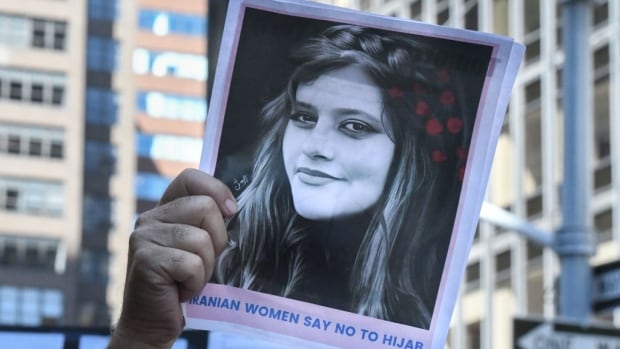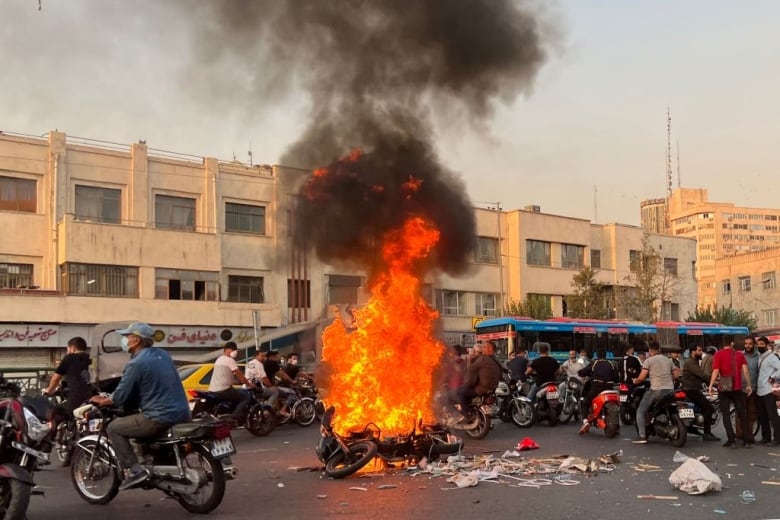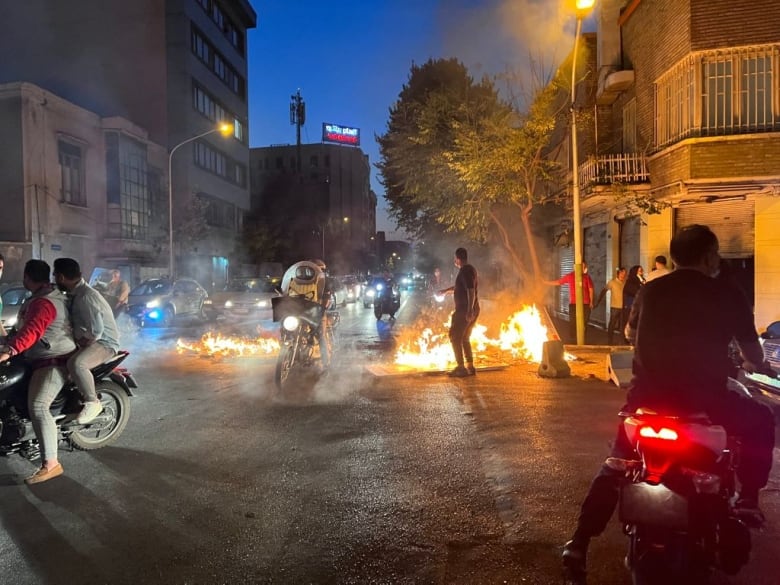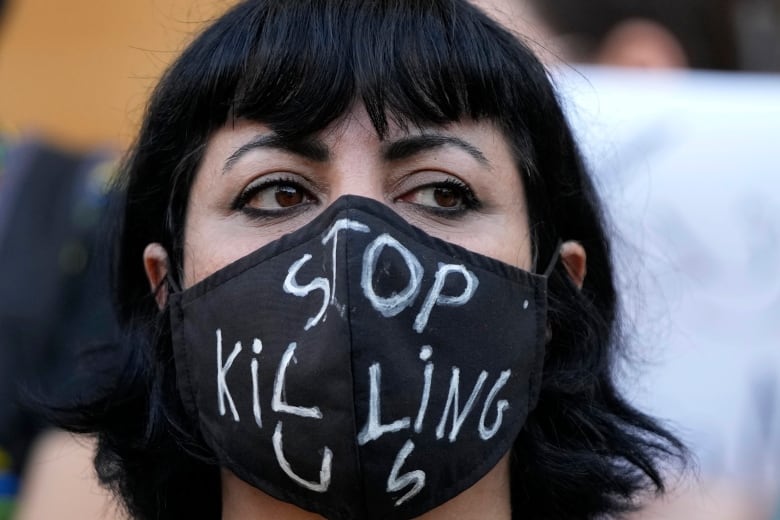
In a central square of the southern Iranian city of Shiraz, Hossein Salami, the commander of Iran’s Revolutionary Guards, vented his anger at the “rioters” who have been protesting across the country for more than six weeks.
“Put aside the wickedness,” he bellowed on Saturday. “Do not come to the streets anymore.”
Salami’s words, captured on video, illustrated how Iran’s regime is losing patience with ongoing revolutionary protests in Iran.
The commander’s tirade signaled that a tougher crackdown is imminent.
“We will turn up at your doors,” he warned, wagging his finger. “We will take revenge.”
Hundreds of thousands of protesters have filled the streets in more than 80 cities and towns across Iran since mid-September. They are furious with the country’s religious restrictions, its autocratic leader and the economic hardships they face.
“People are fed up and have become alive,” said Shirin Ebadi, the only Iranian to win a Nobel Prize, for her advocacy of women’s rights over decades.
“They don’t want the religious tyranny of Iran,” she told CBC News in an interview from London. “They want a democratic and secular government.”
The spark for these latest protests was the death of 22 year-old Mahsa Amini in custody, after she was arrested by Iran’s so-called morality police. She was accused of not wearing her hijab “properly,” not covering her hair as the country’s strict Islamic laws require. Authorities insist she died because of a pre-existing heart condition, and blame the West for instigating the unrest.
At least 450 dead, 25,000 arrested
Amini’s death filled the streets with fury, from women who defiantly threw off their own hijabs and cut off their hair, to students who marched to free themselves from Iran’s religious rule. The movement has spread and now includes a wide swath of society within Iran that has a broader revolutionary aim. They’ve adopted the chant “death to Khameini,” vowing to overthrow Supreme Leader Ayatollah Ali Khameini and the influence of mullahs.
Increasingly, security forces have responded with batons and bullets, killing more than 450 people and arresting 25,000, according to the opposition group People’s Mojahedin Organization of Iran. The country’s judiciary has announced it will start public trials for 1,000 protesters in the coming days, and the mother of one 22 year-old man arrested has tweeted that he has already been sentenced to death in a preliminary ruling.
Still, the protests continue.
No Western media outlets have been allowed to enter Iran, and the regime works hard to censor news and keep information from leaving the country.
But one unnamed protester was reached by BBC News. He said when you go to protest, “You know you might never come back.”
“It’s quite stressful and it’s quite hopeful as well … because you can see that your voice is finally being heard.”
Regime’s crackdown could backfire
Indeed, observers say the crackdown may backfire for the security forces and the regime.
“Their reactions have fuelled the protests more and more,” said Omid Memarian, an Iranian journalist and analyst based in the United States. The regime has a “playbook” on how to stop any demonstrations, he says, but this time it has not worked against a more determined crowd, he said.
“The Iranian government does not get it.”

Since the 1979 Islamic revolution, which overthrew the Shah and brought a new religious dictator to power, Iran has seen several waves of protests. Large demonstrations swelled up in 1999, 2009 and again in 2019, all of them violently suppressed by security forces loyal and ideologically linked to the top leadership.
But unlike previous movements, the current one seems to have inspired a much broader range of Iranians to hit the streets. Earlier protests expressed anger at the lack of human rights, including women’s rights, freedom of speech and political opposition, and the religious oppression felt by secular society.
This time there is all of that, compounded by the frustration of an economy where inflation is more than 50 per cent, with food prices surging and overall growth sagging. That’s brought out the poor and the middle class, and even sparked labour action. Members of the Iranian diaspora describe how students have been joined by their parents and grandparents, waving placards.
“What kind of government is this, that has aggrieved three generations?” asked Ebadi. “That is why I am extremely hopeful about the future of these protests. People are committed, and they want one thing — for this regime to go.”
“Mahsa Amini was the last drop of gasoline that was poured on the anger of the people,” she went on via Zoom. “The situation of Iran is like a fire that is under ashes. Any small gust of wind can flare up this fire.”
‘This movement is a movement of liberation’
Others who have fought for women’s rights in Iran — who have been punished for their activism or forced to leave — are encouraged by the lasting power of these leaderless protests.
“This movement is a movement of liberation,” said Azar Nafisi, who wrote the book Reading Lolita in Tehran and held seminars at her home there in the mid 1990s to discuss the role of women in post-revolutionary Iran with her students.
For women, she said, “this is not just a political fight, this is an existential fight,” revived by another example of mistreatment.

Shahrzad Mojab, a professor of women and gender studies at the University of Toronto, spent years after the revolution working to improve the rights of Kurdish-Iranian women, the same group Amini belonged to, before she left Iran for Canada.
She says much of the push for the current protests has come from young people, who are more aware of women’s issues through social media. They have their own powerful reason for wanting a change of regime: A desire for a better future.
“It’s the grievances and the frustration of youth,” she said, noting they are protesting to counter “depression and anger, no hope, no future, no happiness.”
‘Are the police and army willing to keep firing on their own people?’
But for all the determination of the demonstrators, experts say the chance of their “revolution” succeeding ultimately depends on the cohesiveness of Iran’s security forces.
“The critical question is, are the police and army willing to keep firing on their own people?” said Janice Stein, from the Munk School of Global Affairs at the University of Toronto. Only if “the actual instruments of oppression become convinced that they will lose and that the regime will not endure,” that’s when the protests can succeed, she said, no matter how widespread the unrest.
So far, there aren’t many signs of that breakdown in loyalty.
One key group confronting the protesters is the Basij, men dressed in black, seen arriving on motorcycles with guns or batons at the ready. They’re also known to mix with the crowd in plainclothes and report back to police.
The force was established soon after the 1979 revolution by Ayatollah Ruhollah Khomeini as a tool to Islamize Iranian society and fight internal enemies. It consists of armed brigades, anti-riot forces and a vast network of informers who spy on their neighbours.
To a significant extent, their loyalty and that of the top level Revolutionary Guard is rooted in ideology — indoctrination that the Islamic revolution is a godly struggle against injustice, one that is threatened by the U.S., Israel and Western culture in general.
Against the odds
Saeid Golkar has studied the Basij and the Revolutionary Guard, writing a book on both. Originally from Iran, he teaches political science at the University of Tennessee.
“The possibility of a successful revolution is very, very slight, to be honest,” Golkar, author of Captive Society: The Basij Militia and Social Control in Post-revolutionary Iran, said in an interview from Chattanooga, Tenn.
But he doesn’t dismiss it entirely, because all these security forces are also part of Iranian society, their families facing the same pressures as everyone else.

He shares the story of one family he knows personally. The father is in the Revolutionary Guard; his daughter is a protester who argues with him daily.
“This is just amazing,” he said. “Society is changing and all of society is making demands, even the family of the Revolutionary Guard. If we see this crack in the wall of order and security, then you will see it accelerate very fast.”
The 1979 revolution took more than a year. This one has been underway for more than six weeks, and shows no sign of stopping.